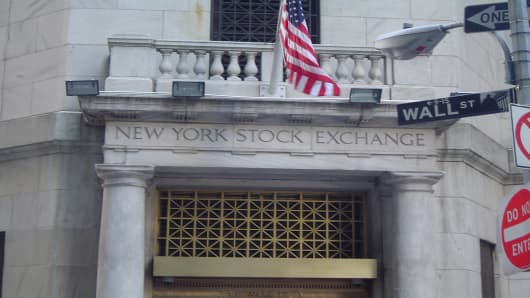Next week is expected to mark the beginning of the US economy’s entry into a recession and the end of the Federal Reserve’s conventional monetary policy to remedy the situation.
On Wednesday, the Fed’s FOMC is widely expected to cut the key federal funds rate another half point, to one percent, in what what many assume will be the end of its aggressive easing campaign.
Then on Thursday, GDP data for the third quarter is expected to show the US economy contracted for the first time in seven years, ending months of speculation that the economy had managed to skirt recession, despite a one-of-kind credit crunch.
Right now, despite an extraordinary confluence of events, the consensus thinking is that these two events have already been factored into the markets. But there’s reason to second-guess that thinking, because the implications are unusually big.
“It's a lot on the plate,” says Robert Brusca, chief economist at Fact & Opinion Economics, who warns the Fed doesn’t want to cut rates “so low, you kind of spook people."
Brusca also says that the powerful negative reaction to weaker-than-expected British GDP data Friday “suggests these economies are weakening faster than people thought.”
For Investors
- Today's Market: What the Experts Are Saying
- Forget About Staying on the Sidelines
- Cramer Explains Market's Wild Fluctuations
- Market Psychologist: Cooler Heads Must Prevail
- 'Sell and Get Out of the Way'
- Why Emerging Markets Are Caught in Crisis
- Crescenzi: The Big Questions Now
- Credit Spreads and Libor Data
The consensus forecast, according to Reuters, is `for a decline of 0.5 percent in US GDP. A small number say it might be as bad as one to two percent.
“It can only be a bad one,” says veteran money manager James Awad of the GDP data. “To the extent that people are depressed, it will depress them further. The mood is worse than anything I’ve seen.”
Brian Bethune, chief US economist at Global Insight, says the US is fighting three battles: an economy in recession, a lockup in financial markets and general deflation.
“It’s certainly historic,” says Bethune, chief US economist at Global Insight.
Historic, yes, and perhaps even a bit enigmatic.
The Fed—Go Figure
Though the Fed has taken interest rates to 1 percent before, it’s the first occasion in modern times where there’s actually debate about it going even lower—especially when there’s a sense that the Fed regretted going that low the first time around.
What the FOMC members do next Wednesday may offer some clues.
“I don't agree with the markets it’s a guarantee they'll come down again,” says economist David Jones of DMJ Advisors. “The Fed has shot most of its ammunition. If they come down, it’s sort of the last move. So what do you gain from it?”
Jones says the Fed essentially made its October rate cut earlier in the month when it acted in concert with other central banks.
Others like Bethune says the Fed has no choice but to cut and will go as low as zero, if necessary. Having repeatedly said it is prepared to act as necessary, “the Fed has to walk its talk,” he says.
“Every cycle, people say what good is another 25 or 50 basis points,” says Bank of Tokyo-Mitsubishi economist Chris Rupkey. "It’s the cumulative effect of cutting rates.”
The problem may be beyond interest rates by now. That—and all the other innovative and drastic steps taken by the Fewd and Treasury—may help explain why Chairman Ben Bernanke endorsed yet another fiscal stimulus plan Tuesday.
“He's signaling they’re near the end,” says Jones. The “Fed’s done everything you could ask.” It’s other central banks that need to cut rates aggressively, he adds.
“It’s strictly triage,” says economist Ken Goldstein of the Conference Board, referring to the need to stir lending at any rate, not that the over-leveraged and tapped-out consumers are the least bit interested in borrowing.
The Economy—Gone Fishin'
For some time now “you have a consumer that’s basically been saying if we don't have to (buy someting) now we're not doing it,” explains Goldstein. “I doubt it will change over the next 12 months, no matter what Bernanke does, what GDP does, even what the jobless rate does.”
That will be a critical factor going forwards and explains why the GDP data should not be taken lightly. The third quarter, as observers like to say, is when things fell off a cliff.
In August, the conference board’s consumer confidence index was the lowest in its long history. Consumer spending almost certainly declined in the third quarter for the first time in almost two decades and is expected to do so again in the fourth quarter.
A rising unemployment rate—some say as high as 8 percent—will feed into that, hurting retailers from Wal-Martto Nordstrom.
The trade sector—long a source of strength—is weakening, as the dollar appreciates and export demand slows with general economic growth overseas.
What’s more, capital spending is “getting ready to plummet,” worries Rupkey.
Jones, who expects the economy to shrink by 0.5 in the third quarter, is forecasting twice as much, “maybe worse than that” in the fourth quarter.
For Jones and others, there’s even a distinct possibility the contraction will extend into the second-quarter of 2009. It’s a “deep and long recession,” he says.
Two key factors on the consumption side will be the timing of the housing recovery—a key element in the wealth equation—and the contents of the federal government's second and widely anticipated fiscal stimulus package.
And there are all the assumptions about the government’s untried bailout efforts, from recapitalizing big financial firms such as Morgan Stanleyand Citigroup to buying distressed mortgage securities to defrosting the credit markets.
The commercial paper market, through which many a corporate payroll passes, hasn’t been the same since its major player, Lehman Brothers, filed for bankruptcy protection.
“Consumers are learning very quickly that Wall Street’s problems are their problems,” says Rupkey.




